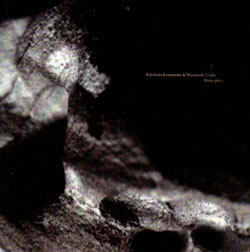
Many artists rely on technology to goose ideas. However, once they're bored with the immediacy of whatever neat, fad gear they used on an album, the tiring search continues — great, you found a new toy, but did it or you make something new; and how many other people are out there with the same template, ready to release similar results?
It's hard to explain why this doesn't apply to a musician who looks for acoustic spaces to trigger creativity (I guess you can call it a style issue?*) The crux and shtick of improvising cellist / violist Kuwayama Kiyoharu's (aka Lethe) performances and recordings is his knack to selectively pick a resonant abandoned industrial warehouse and develop a rapport through listening and interaction, even incorporating the "metal junk, wood sticks, etc." found there into his works.
Here at the No. 20 warehouse, Nagoya Port (Lethe's amazing Dry Ice On Steel Tables was also set in this space), Kuwayama and sax player Masayoshi Urabe create a spectacular, dreamy wash of sounds that suits the title's dictionary definition of "incorrect or perverted perception of what is seen (read: heard); hallucinatory vision". They first acknowledge their element, walking through the space, stepping through the debris, kicking through sticks and gathering materials. Someone literally sprints to a corner then we hear the subtle breath of Masayoshi, augmented and relocated by the enormity of the room. He coaxes the momentum with short, dynamic bursts; Kiyoharu punctuates his entrance with more dropped items before joining on cello. They continue with this build and settle into a sometimes-sweet, sometimes-sweetly-dissonant lyricism. Near the ten-minute mark, Kiyoharu bows out, leaving Masayoshi with his pauses and birdsong beeps; Kiyoharu signals the close of this chapter with a jolting slam of metal.
The furious moments come when the duo shows off their technical mastery, the rapidity of events turning into dense, reverberating clusters of pitch material and harmonics. Sometimes the "junk" is less side note and more of a rhythmic bed that unites with Masayoshi ŕ la Interstellar Space. And there is a lot of physical movement; at twenty-six minutes, Masayoshi, moving away from of the previous intense volume, begins a staccato series while pacing the entirety of the warehouse — walking out the door at one point, I believe.
Anyone familiar with our site knows that The Squid's Ear is a forum for unusual music: the techniques and craft of the artists we review here all generally attempt to offer both a new voice and queries about "What is music?" Kuwayama and Masayoshi further pose "Where is music?" There is no plug-in for that.
*Further style points are given to the man for saying the following:
"If a record has been released and someone has paid the necessary price for it, how they choose to listen to it should be up to them. When I buy a record and it doesn't quite hit the spot, often I will try listening to it through a guitar amp, or equalizing it, or manipulating it in some other way."
Comments and Feedback:
|



